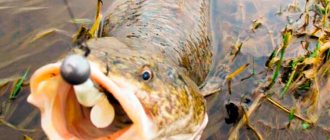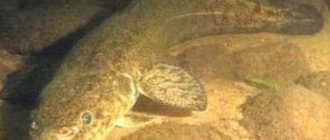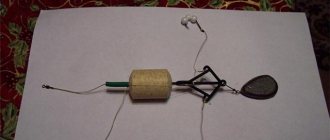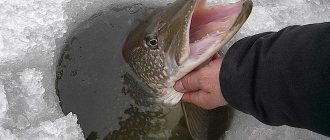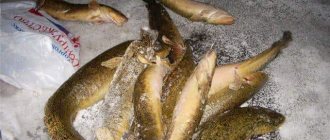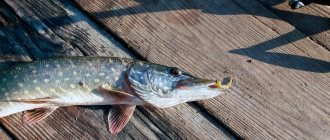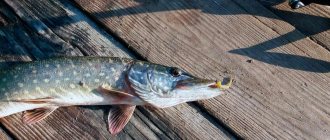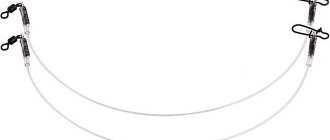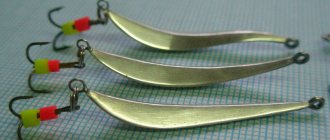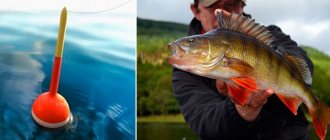Author of the article
Andrey Soprykin
Professional fisherman with 23 years of experience.
Articles written
85
When the water temperature drops below +13 degrees, most fish go into torpor. However, this does not mean that it doesn’t make sense to go fishing from mid-autumn to spring. This time is ideal for catching burbot, which, on the contrary, becomes active. This predator from the Cod family lives mainly at the bottom of the reservoir, so the most effective tackle is the donka.
We recommend a very useful video:
Features of predator behavior
Before catching burbot, you need to become familiar with the peculiarities of its behavior so that your fishing is productive. It makes no sense to go after this predator in the warm season, when the temperature is above +13 degrees. During this period, he is passive and very rarely goes hunting. It's almost impossible to catch him. You can catch it from about mid-autumn in central Russia, but the most favorable time is in winter, from December to mid-February. If you do everything correctly, you can achieve a good catch, even get trophy specimens.
Expert opinion
Valery Andreevich Sizov
Professional fisherman with 35 years of experience
Note! Winter fishing for burbot requires special equipment. The one used for fishing for other predatory fish is not always suitable.
Burbot does not live in areas with a muddy bottom covered with vegetation. He prefers places with stones and snags, behind which he can hide. The predator swims out to hunt only at night. The worse the weather, the better. This fish loves rain, snow, wind, preferably there is no moon in the sky. In the pre-dawn hours, she retreats back into the holes at the bottom.
Spawning of burbot begins in the middle of nowhere, i.e. in January-February. During this period, females spawn in areas with pebble and sandy bottoms. The fry have time to grow up before the activity of other predators, feeding on the eggs and small things of other fish.
In winter, burbot creates its own route, which patrols daily in search of food. Fishermen call such paths trails. If you manage to find them, you must remember to go there for burbot every time. It is recommended to look for the predator close to the shore. In places where there is snags, tree roots, etc. in the reservoir. The fish will attack prey well in areas at the exit of a deep hole, at the bottom with gushing springs. The predator can also move away from the shore in bodies of water with standing water. It will be easier to reach such areas on ice.
If you want to be healthy, toughen up!
Take this expression as a motto if you are going to catch burbot. This predator, unlike its fellows, leads an active lifestyle when the water temperature drops to 12 degrees and below, and its spawning period begins from the end of December and lasts until mid-January.
As the temperature rises, burbot goes to secluded places and plunges into a kind of hibernation. During the year, two bursts of activity are noted: before freeze-up and after spawning.
Of course, the weather will be very cold and will seriously test your immunity, so it is recommended to carefully consider the issue of equipment.
Be careful with your hands : the body of the burbot is abundantly covered with a specific mucus, which upon contact will remain on the skin, so always have some kind of natural cloth with you to wipe your hands dry from mucus and water. Otherwise, you risk getting frostbite.
The most effective donks
There are a lot of such gear. However, not everyone shows good results when catching burbot. Let's look at the best donks for this predator.
With hook
To make it yourself you will need:
- extended spinning rod with a reel for long-distance casting;
- a reel or an ordinary plastic bottle for fishing near the shore;
- main fishing line with a minimum cross-section of 0.3 mm (the predator lives on a rocky bottom with snags, so it will easily get caught; if this equipment is thick, then you can safely pull it without fear that it will break);
- a sinker with a mass depending on the current and casting distance (it should not be carried away by the flow);
- leash made of monofilament fishing line with a cross-section of at least 0.25 mm;
- hook No. 8-12, depending on the size of the intended predator (there must be a long and thin shank so that it can be easily removed from the mouth after fishing).
How to make tackle correctly:
- Wind a fishing line no longer than 50 m onto the reel or reel (it is not provided for longer casting of the donk).
- Attach a sliding sinker to its end, limiting movements with stoppers.
- After about 40 cm, attach a swivel to the bottom or make a loop for a leash with a hook.
- Tie it with a figure eight.
If you plan to fish near the shore, then you can use a regular plastic bottle as equipment instead of a reel:
- Use a thin drill to make a hole in the lid.
- Thread the fishing line into it and secure it with a stopper so that it does not fly out.
- Wind the line in the middle. Many bottles have a recess there, which will be more convenient.
- Right at the fishing spot, unwind the required length of fishing line, make a loop at the end and place it under the wound elastic band for money.
- Make a cast, after which the bottle will stand upside down.
- When the fish takes the hook, the loop will come out from under the elastic. The bottle will become a kind of bite alarm: it will turn upside down.
- The most important thing is not to forget to tie a rope to the bottle and secure it on the shore.
Rice. 1. Donka for burbot from a kefir bottle.
With two leashes
How to make such a donka with your own hands:
- Repeat all the steps (as in the previous manufacturing method), only add not one, but two leashes with a hook.
- They should be approximately 50-60 cm apart from each other. If it is less, the leashes will begin to constantly get tangled with each other.
Expert opinion
Valery Andreevich Sizov
Professional fisherman with 35 years of experience
Note! Experienced fishermen rarely use this type of donkey. They believe that the catch is not getting any better. In addition, even if the leashes are properly fixed, there is a risk of them getting tangled or caught on snags at the bottom. A single line will be easier to release than a double line.
Rice. 2 Donka with two leashes.
Winter donka
An excellent option for winter fishing for burbot is the winter donka. Other types of this gear may be lost because In cold weather, the holes quickly become covered with ice and are covered with snow. This will not happen with a winter donka (zherlitsa). How to make it yourself:
- Use plywood about 1 cm thick and 20-25 cm long as a platform.
- Make slits toward the center with a drilled hole 1.5 cm from the middle.
- Insert a polypropylene pipe with a diameter of about 25 mm and a length of 20 cm into this hole.
- Attach a medium-sized inertial coil to it.
- Place a spring of approximately 20 cm at the top of the pipe. Attach a red flag to its free end. This will be a bite alarm.
- The spring should bend in the shape of an arc and rest freely on the reel with wound fishing line.
- When the burbot bites, the flag will rise, so the fisherman will know about the bite.
Expert opinion
Valery Andreevich Sizov
Professional fisherman with 35 years of experience
For reference! The plate is installed on top of the hole, so it does not freeze or become covered with snow.
Rice. 3. Homemade donka on a plywood plate.
Donkey rig for burbot
The donka (aka a snatch, a delivery) has been simplified to the limit so as not to grieve too much about the loss of gear:
- the main line with a diameter of 0.7 mm usually does not exceed 10–15 meters in length;
- a lead sinker of any shape and a pair of leashes 30–35 cm long and 0.5 mm thick are attached to it. (In fact, both the main fishing line and the leashes can be made twice as thin, the burbot will not break. But a thick fishing line gets tangled less at night, and the stronger the tackle, the fewer hooks it ends up breaking.)
- hooks are tied with single hooks No. 7 - No. 10, depending on the nozzle.
- a reel of arbitrary size and shape is made from a variety of materials: cut from wood, sawn from plywood or plastic. Some fishermen glue a strip of polypropylene foam along the reel to stick hooks into it, others stick hooks (there are from one to three of them on a burbot cast) into a separate piece of foam plastic.
Sometimes a reel with a pointed peg end is cut out of a board (usually linden, which is the easiest to work with), then on the pond you don’t have to look for something to securely attach the hook to. This design is sometimes simplified by driving two nails into a peg or screwing in two screws, onto which the fishing line is wound.
Such a design solution cannot be considered successful: the fishing line in places of contact with the corroding metal of nails or screws quickly loses strength; if you insulate the metal (for example, with pieces of cambric), then the wound fishing line, contracting when it dries, often bends the nails and tears the screws out of their sockets.
Since trinkets are usually displayed in considerable quantities, the task is to minimize their total weight and volume. Some fishermen, as in the case with subs, make sinkers for bottoms on the spot, from pebbles. Naturally, you can fish this way only in well-known reservoirs, and when going to new places, you still need to use traditional lead sinkers.
Another method to minimize the volume and weight of gear is to use multi-cell reels: from 10 to 15 reels are wound on one, usually of the same length. Since when installing gear stored in this way, the reel remains not on the pond, but in the fisherman’s backpack, then all the fishing line is used when casting, and there is no need for an extra supply (burbot fishing lines that are too long often get tangled in snags). On narrow forest rivers with a depth of no more than 2 m, a five-meter main line is quite sufficient; however, it is not a bad idea to have a skein of thick fishing line in stock so that, if necessary, you can quickly lengthen the tackle.
It is convenient to have several of these large reels with you, with hooks of a certain length wound on each one, - then for any place you like on the river you can choose the appropriate size tackle. At the same time, on the reels it is worth indicating the length of the wound donks with numbers, in order to avoid confusion.
Bait
Before catching burbot on a donk, you need to decide on an effective bait. Live bait is best suited for this task. Experienced fishermen recommend choosing perch or ruff. The second fish can be used even without a hook; the predator will catch on its spines when it swallows. The most important thing is to tie the line firmly to his tail. Other fish, such as roach, etc., are also suitable as bait.
In August, you can catch small frogs and keep them in a jar with fresh grass or in a special aquarium for land turtles. The most important thing is to leave holes for air penetration for amphibians, and periodically clean the container. The jar or aquarium should be kept in a cool place, for example, in a basement or cellar.
You can also collect worms in late summer or early autumn. At this time of year they live in the surface layers of the soil. Closer to winter, they crawl into the depths; even if the ground does not have time to freeze, it will be problematic to get them. Before fishing, worms should be kept in a tin can or other similar container filled with soil. Place it in a cool place, maybe on the balcony or in the refrigerator. Large worms are suitable as bait for burbot; if they are small, it is recommended to attach them in a bunch.
If the bait listed is not available, you can use a store-bought alternative. The predator goes well on pieces of beef and pork, sea and freshwater fish. You can use chicken giblets, lard and other meat by-products.
Expert opinion
Valery Andreevich Sizov
Professional fisherman with 35 years of experience
Note! It makes no sense to catch burbot using bait of plant origin. He definitely won’t react to it, unlike small conventional predators (Amur sleeper and others).
Rice. 4. It is best to attach the hook to live bait on the back. This will ensure good movement in the water. The hook can also be inserted into the upper or lower lip.
Bait for catching burbot with donks in spring
The main bait for burbot is a large and medium-sized worm 6-10 cm long. Smaller worms are placed 3-4 per hook, large worms one or two, resulting in an appetizing bunch. If a burbot stands on a spot, then sooner or later it will become interested in the bait. Considering that fishing is carried out with 3-4 fishing rods, you should have 2-3 good portions of the worm. In principle, any worms will do. You can also use white ones. They have a tougher skin, they are thick, and they are not eaten by small things, as happens with dung.
If we use such worms, it is better to tie hooks No. 8. The worms should be pierced in three places: at the beginning, in the middle and at the end. Having pierced in this way, we move the worm tightly along the fore-end and insert the next one. It is not necessary to leave the sting open. When the bundle is formed, there is not much difference in what the sting will be. If your worm is too large, it is better to halve it and put it on different hooks.
They successfully catch burbot using both live and dead fish. This could be a small perch or ruff, roach and rudd, or a gudgeon. Sprat cut into pieces also works well.
As for baits, as a rule, they are not used when fishing for burbot. If you have enough worms, you can chop them up and mix them with soil and roll them into balls. Throw a few balls into the donk casting areas. Sometimes this method makes the burbot peck more actively.
Fishing technique
Before you go fishing, you need to check the weather forecast. As mentioned earlier, burbot loves bad weather and will not bite on a warm moonlit night. It is recommended to take several bottom gear with you at once in order to place them along the entire coast in interesting areas and at different depths. It is recommended that they be equipped with a bite alarm (for example, a bell). Its sound will be clearly audible to the fisherman at night. If flags will be used as signaling devices, then lights should be installed next to them so that you can see when they give the sign. As practice shows, burbot are attracted to their light and the fire of the fire.
When there is no bite alarm, it is recommended to check the gear after casting every 30-40 minutes, gently pulling the line. If the predator is on the hook, you will feel the heaviness. All that remains is to make a light hook against the current. You need to be careful when the fish is close to the surface of the reservoir. At this moment, she has a habit of making a sharp jerk and getting off the hook.
If burbot is caught using girders, then you need to make several holes in the ice at once and place them on each tackle. Check every 30-40 minutes. It is also necessary to periodically inspect live bait; dead and spoiled pieces of meat must be replaced. However, when you don’t want to sit and wait for a bite, you can go home until the morning. If the fish stays on the hook for several hours waiting, nothing will happen to it.
Rice. 5. The more donks there are in the ice, the greater the chances of a good catch in the winter season.
Nuances when preparing gear
To catch burbot, use standard donks. The only feature is the hook. It should be quite large (preferably No. 10-12) with a long fore-end. Fishermen call this predator greedy.
Indeed, it swallows the bait deeply and firmly, so that there are practically no escapes. But such a grip causes a lot of difficulties when you need to remove the fish, so using a hook with an extended shank will greatly facilitate this process. It is better to have enough leashes in stock. The question here is not only about the greed of burbot, but also about fishing at night. There will definitely be snags, and it is better to prepare the leashes at home under normal conditions than to knit them in the dark.
The sinker should be chosen based on the relief and type of bottom. Any type of load can be used in clean areas. Where the bottom is rocky or snaggy, take oblong weights. Some fishermen prefer the same Tyrolean stick.
The strength of the rod begins to play a role when moving to more northern places where large specimens are found; in the middle zone almost any one will do.
Useful tips
Since burbot becomes active only after the onset of cold weather and at night, you need to take care of warm uniforms, spare clothes and shoes, hot tea and food in advance. It is also recommended to take a tent with you to provide shelter from wind, rain and snow.
If fishing will be carried out from ice, before stepping on it, you must make sure of its strength. It is advisable to light a fire and light lanterns near the fishing spot. This will make the fisherman more comfortable, and the light will attract predators. If there are many people fishing nearby at once, it is advisable to feed the burbot with finely chopped worms or minced meat so that it swims to the required place and lingers there, and does not start pecking at others.
Recommended viewing:
On the donkeys in the fall
No feeder? Take the hooks, re-equipping them with thinner fishing line and small hooks. Fishing report.
All summer my namesake, called sashka 007 . A sort of agent James Bond 007... And I have a lot of work in my house and in the autumn garden there is also enough of this work. No time for fishing, probably for the first time in my life. Previously, sinfully, I followed the principle: if work interferes with fishing, quit work!..
But then I managed to go for a day. In addition, the youngest son had long been asking to take him fishing. In a word, everything worked out. But again there’s a problem: after moving to a new house, it’s not clear where everything went missing? Instead of a feeder, I had to take hooks, hastily re-equipping them with thinner fishing line and small hooks, and on the main fishing line I put feeder cage feeders, some 100 grams, some 40, but with added weight. I bought Unikorm for feeders. Bream". I also cooked millet and pea porridge for volume.
We arrived at the river after dark, parked the car near a tree stump, and looked around. The autumn night was still all around, dark, without light. Naturally, they didn’t wait for dawn. And since you always forget something, you forgot your headlamps. I had to plant corn, maggots, pearl barley, worms and cast the gear using mobile phone flashlights, which is not entirely convenient.
I must say that Sanya’s namesake mastered well over the summer this river reach and the hole on the opposite side of the river, where he caught large bream and crucian carp weighing more than a kilogram. I showed the place to him and my other fishing colleagues and the site when we were here last fall for burbot night fishing. But he never showed up here again. And these places sank into Sasha’s soul. I never went anywhere else. And then the fish began to appear after the killing period of the “cursed” days, when marginalized non-humans with electric fishing rods ruled here. And as Alexander himself said, he switched from spinning to feeder thanks to this very place.
So, the first casts... As I understand, the namesake did not choose the place by chance. He threw a couple of feeders right to where I once stood on a boat, tied to a tree that had fallen into the water. There I caught bream and bream, and occasionally ide. Below the tree there was an exit from the pit to the riffle. And the place is relatively clean, without snags. Yes, this is where the hooks of my “ring” and the donkey with a feeder on the fishing line were. But now it falls to us to place our donkeys a little higher. I aimed right under the fallen tree. Also a good place, but then I left three feeder feeders on it and next to it. I miscalculated a little when casting the bottom, throwing the sinkers with hooks, ending up in the very snags of the pit.
And here are the first bites. At first they were with Sasha. A palm-sized roach was pecking. Moreover, the bait was canned corn, which was new for me at this place. Only on ponds did I use corn for carp. And then Sanya even got the hang of catching a trap. And in the summer, bream and crucian carp pecked on the corn.
In the morning, the sorog only ate soft corn. But most often - from Alexander. Still, the place played its role, but he also had more responsive and subtle tackle. Okay, let him catch it. The main thing is that my child, who also rarely goes fishing, catches something, and my task this time is to breathe in the river and forest autumn air for future use and add fresh photographs... There will still be fishing. Meanwhile, for some reason, the “child” took a liking to the right bottom, closest to the willow bush. By the way, the child is already nineteen years old, and he is almost a head taller than me. But here’s the child and that’s it... that same Vanka, who showed up his photographic face in many fishing newspapers and magazines in Moscow and Nizhny Novgorod. And it was as if the son felt what kind of tackle to attach to... It was on this donk that he caught a bream - the only large fish this time, and on the next hook Ivan missed a pike that took it to the track. Cut it, toothy, a simple leash designed for roaches. That’s how it happened this time: Sanya caught a catch, we also pulled a little roach with a white bream at the head, well, the pictures, fresh air, the lonely “croon-crown” of a soaring raven, the quiet ringing of a dim autumn day - that was all that was needed a fisherman in his simple hobby, and for some, life...
Alexander Tokarev
Episodes of summer are a joy to the soul
For crucian carp in Senkino
Fishing on a rural pond
